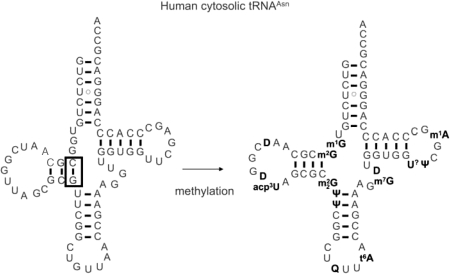Nucleic Acids Res., (2006) 34, 721–733
The author wishes it to be known that there was a print error in Figure 4 of the above mentioned article. A corrected figure is shown below with its legend.
Figure 4.
Rearrangement on the secondary structure level induced by double methylation of human cytosolic tRNAAsn. The calculated structure of the unmodified transcript on the left side features an aberrant D-stem without G10, but including G26. Double methylation on N6 of G26 impedes its Watson–Crick pairing with Cytidines and thus renders the base pair G26-C11, which is highlighted by a box, impossible. The fully modified tRNAAsn may thus adopt the classical cloverleaf structure as shown on the right. U? denoted an unknown modified uridine, likely a derivative of ribothymidine, at position 54.



